"Ruk-Zuk rifle" by Ritter von Mannlicher

A still from the film “The Green Van” (1983), where we see the main character with a Mannlicher in his hands
“Green Van”, A. Kazachinsky
History weapons. Finally, in a series of articles about Ritter von Mannlicher’s weapons, we came to the M1895 rifle (German: Infanterie Repetier-Gewehr M.95 - “M95 Infantry Repeating Rifle”), which used an improved version of his revolutionary straight-bolt bolt, very similar to the one he used in the M1890 carbine.
It should be noted that it was by no means the result of any “insight” of its creator, but, on the contrary, it was the fruit of his gradual, long and persistent work from one sample to another and their consistent improvement. Technologically, the rifle turned out to be more complex than other types of rifles adopted for service in the early 90s of the 1898th century. But, on the other hand, she was distinguished by high fighting qualities. Thus, it was the Mannlicher that the last Russian Emperor Nicholas II loved to shoot in his park. True, at the very end of the First World War, Austria-Hungary began producing Mauser rifles rather than Mannlicher rifles, and all because the XNUMX Mauser was more technologically advanced in production and required less metal. But, be that as it may, no one criticized the already produced rifles; on the contrary, their convenience and reliability were noted. By the way, among the officers of the Russian Imperial Army in the pre-war years, it was customary to scold this rifle for the hole in the magazine through which the used pack was removed. Like, dirt will get inside through it. But as it turned out, they scolded in vain: as the dirt got in, it fell out through this hole.

Mannlicher rifle M95. Army Museum, Stockholm
Austrian troops nicknamed it "ruk-zuk-rifle", which colloquially means "back and forth". Its main producers were the companies ŒWG in Steyr and FEG in Budapest. The rifle was originally chambered for the 8x50mm R round-nose cartridge, but in the 1930s it received the more powerful and long-range Spitzer 8x56mm R cartridge.
The M1895 rifle was unusual primarily in that it used a direct action bolt, as opposed to the more common bolt action of the time. It had a twin-lug rotating head, similar in design to the Mauser rifle bolt, but with a pair of helical grooves cut into the body, which converted the back and forth movement of the handle and bolt body into a rotating movement of its head. The protrusions on the bolt body were located relative to the helical grooves in such a way that the first 20 mm of the bolt body stroke moved its head back only 3 mm, which ensures the initial removal of the spent cartridge case from the chamber. It turned out that a shooter with such a rifle made one less movement than a shooter with a bolt-action rifle. Therefore, the Mannlicher rifle had a higher rate of fire (about 20-25 rounds per minute) compared to other rifles, although this advantage required good care. During army testing in 1892, the rifle withstood all the “torture” to which the military subjected it, including firing 50 rounds without any lubrication.
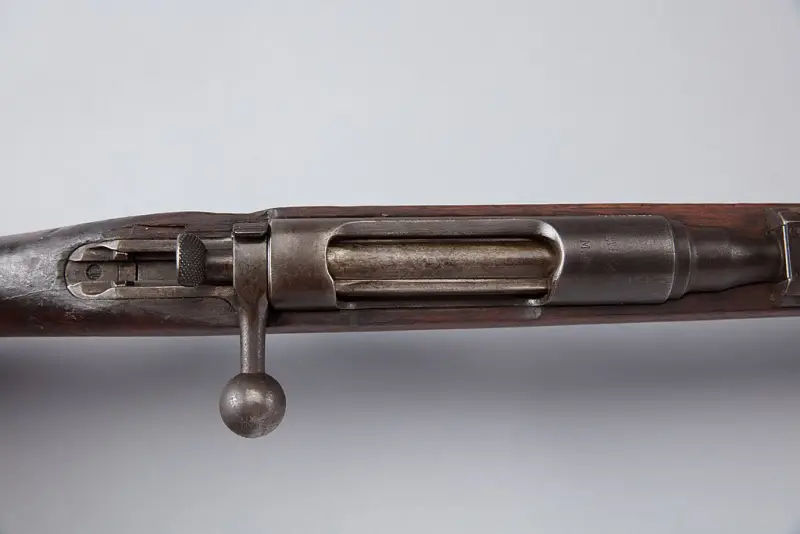
Straight action bolt of the M95 rifle. Auckland Museum, Australia
The rifle was loaded using a five-round pack, which, when loading the magazine, was inserted into it from above through the bolt and held in the magazine until it contained at least one cartridge. When the last of the five cartridges was inserted into the chamber, there was nothing left to hold the pack inside, and it simply fell out of the lower hole under the influence of gravity. There was a button at the front of the trigger guard that allowed the shooter to remove a partially or fully loaded packet from the magazine while the bolt was open to unload the weapon. In this case, the clip will be thrown out of the rifle quite energetically, since the entire force of the pusher spring will press on it. The rifle was not designed to be loaded in any other way than using a stack, meaning it was impossible to insert cartridges into its magazine one at a time.
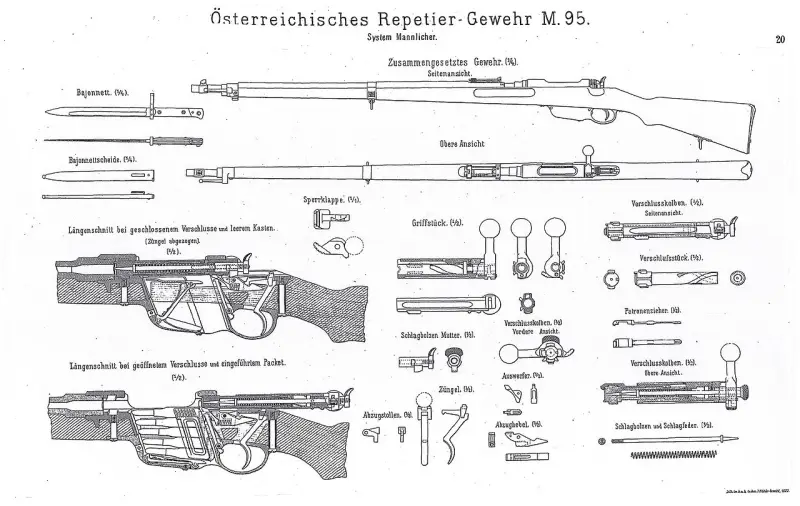
Diagram of the M95 rifle
The rifle was initially adopted by the Austro-Hungarian army and was used throughout the First World War, and after the war was used by both the Austrian and Hungarian armies. The main foreign user was Bulgaria, which acquired large quantities of weapons from Austria-Hungary starting in 1903 and continued to use them during the Balkan and both World Wars. After the defeat of Austria-Hungary in World War I, many M1895 rifles were transferred to other Balkan states as war reparations.

Bayonet for the M95 rifle. Army Museum, Stockholm
Some of these rifles were used in World War II, especially by second-line soldiers, reservists and partisans in Romania, Yugoslavia, Italy and, to a lesser extent, Germany. After the war, many were sold as cheap surplus into the hands of African guerrillas in the 1970s, and some were exported to the United States as sporting and collectible firearms. The M1895 bolt served as the model for the ill-fated Canadian M1905 Ross rifle, although the later M1910 used complex interrupted threads instead of two solid lugs.
The M1895 was originally chambered in 8mm M.1893 (8x50mm R Mannlicher). Between the world wars, both Austria and Hungary converted most of their rifles to fire the more powerful 8x56mm R cartridges. Yugoslavia converted its captured M1895s to fire 7,92x57mm Mauser cartridges, with a clip rather than a burst , food. This modification was designated M95/24 and M95M. The M95/24 is often incorrectly attributed to Bulgaria, but the 8x57mm cartridge was never the standard cartridge of the Bulgarian army.
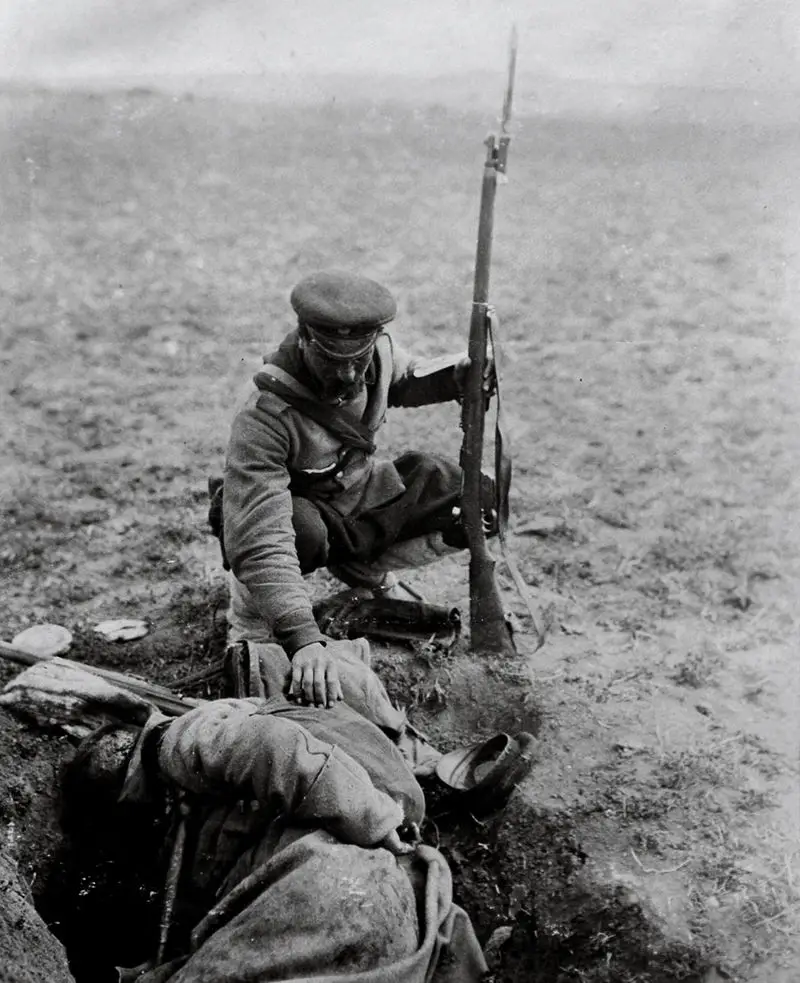
Bulgarian soldier with M95 rifle on the battlefield of World War I
The sights had a graduation of 300-2600 steps (225-1950 m). The carbine (official designation in German: Kavalerie Repetier-Carabiner M1895; "M1895 Cavalry Repeating Carbine") also fired the 8x50mm cartridge and replaced the M1890 carbines. The carbine's sight had a graduation of 500-2400 steps (375-1800 m). Although it originally did not have lugs to attach a bayonet, during World War I a lug was installed on the barrel to mount it as cavalry units were found to be ineffective.
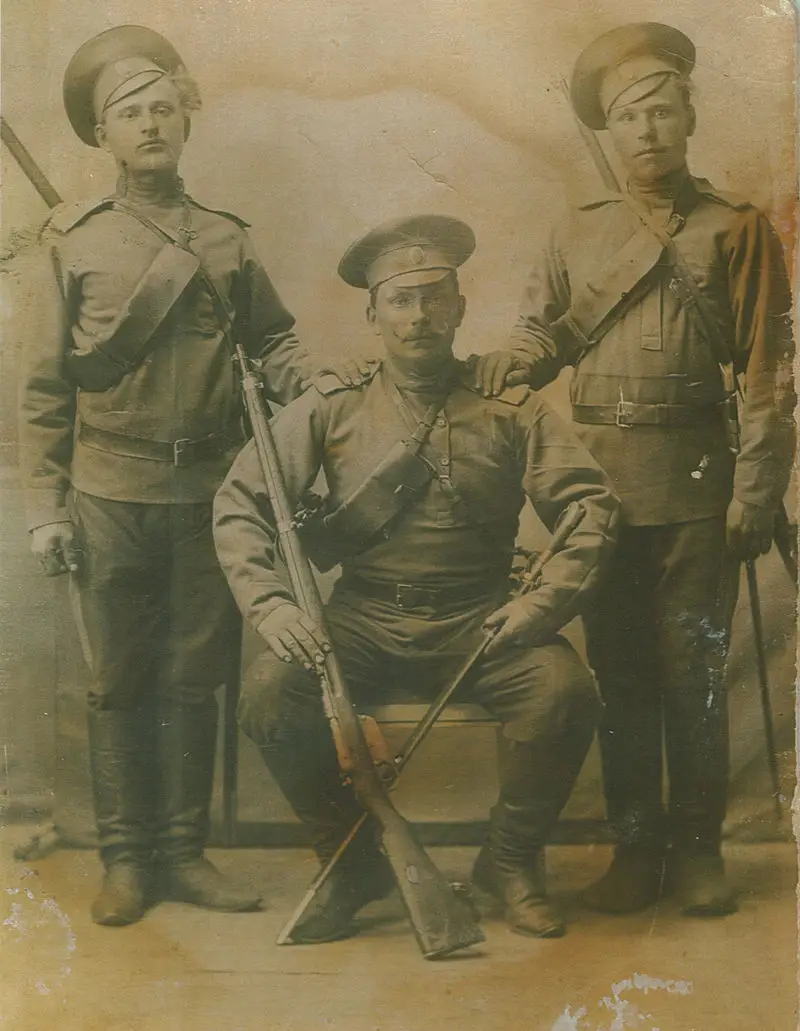
Russian Cossacks also did not disdain captured Mannlicher rifles!
After 1938, Hungarian soldiers in rifle companies were re-equipped with the new 35M rifle, but most of the soldiers (machine gunners, supplies, sappers, artillerymen, messengers, etc.) were still armed with Mannlichers. In mid-1940, the Royal Hungarian Defense Forces had 565 thousand rifles in service. Of these, 105 thousand were new 35M, and the rest were... Mannlichers. During 1941, 30 thousand 95M rifles were modernized for new cartridges. After 1941, only the 35M (and its version chambered for the Mauser cartridge) were produced, so the number of Mannlichers in the Hungarian army was constantly decreasing. In addition to losses, significant wear and tear on already quite old rifles that had served for decades also played a big role in this. But the Mannlicher still remained an almost exclusive type of rifle in some formations, for example, in sapper and artillery units.
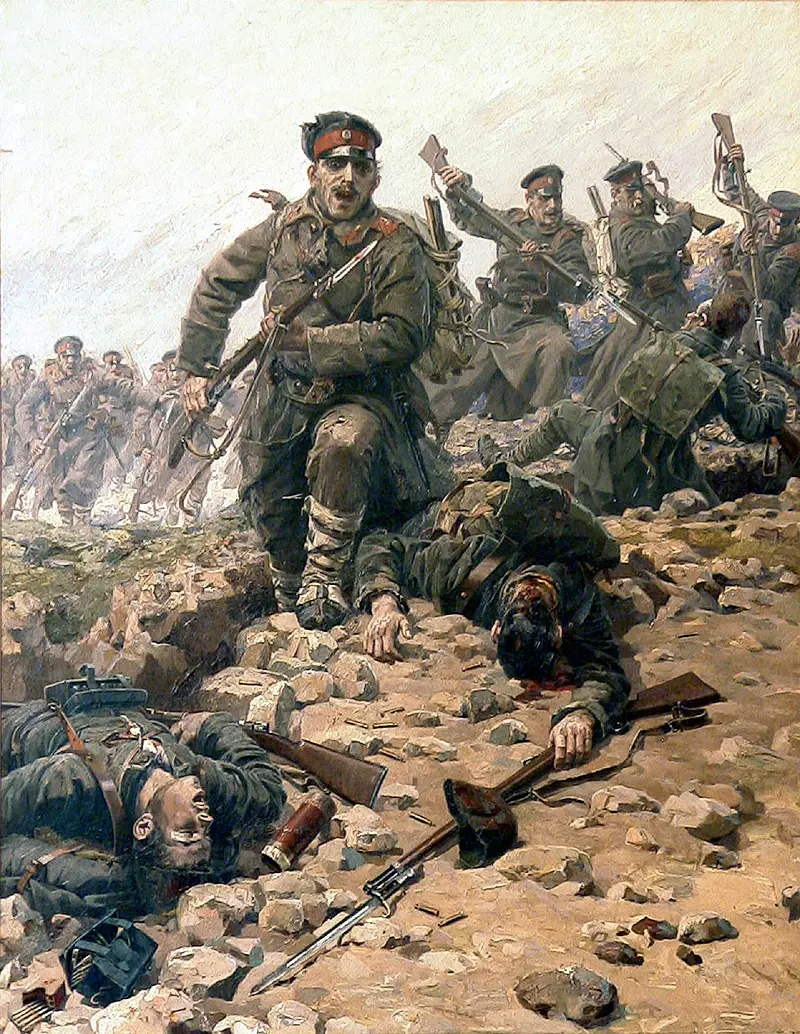
Painting by Yaroslav Veshin “On the knife!” This is the battle cry of the Serbian infantry. There is a known curious episode of the Civil War in Russia, when during the assault on Kazan by white units in 1918, a group of Red Serbs, who were in a chain of Red troops defending the approaches to the Kazan Kremlin, suddenly shouted “To the knife!” rushed at... the Red Army soldiers fighting next to them and thereby contributed to their defeat by the Whites
This led to numerous problems during the 1945 battles, as the weapon began to experience frequent bolt jams, primarily due to thermal expansion. And when a soldier tried to force open the lock, its old metal could crack. After 1945, several copies of the Mannlicher, despite their wear and tear, were still used in the restored military, border and police units. It is noteworthy that more 31M rifles survived in neighboring countries than in Hungary itself, where large volumes of weapons were confiscated and destroyed after the events of 1956. Nevertheless, Mannlicher's M95 rifle has come a very long and glorious way, and its design influenced many other small arms.
Information